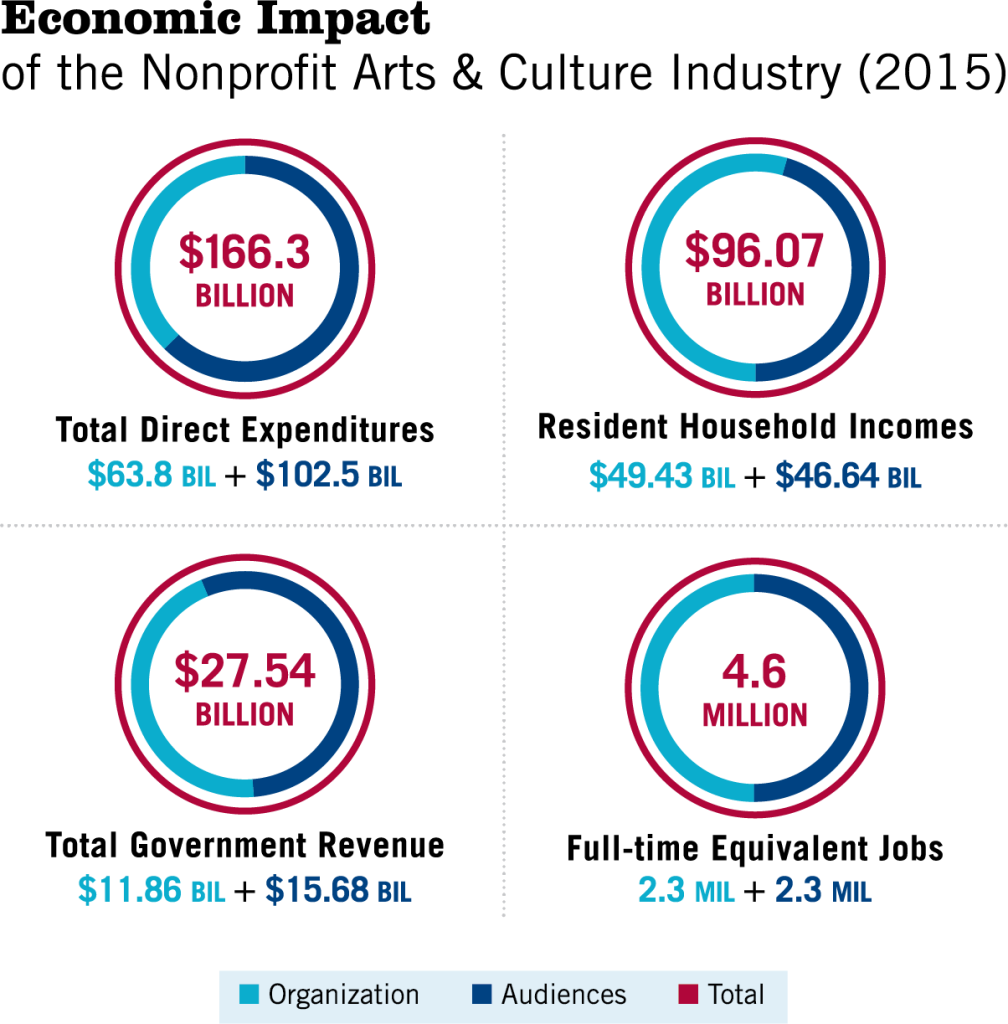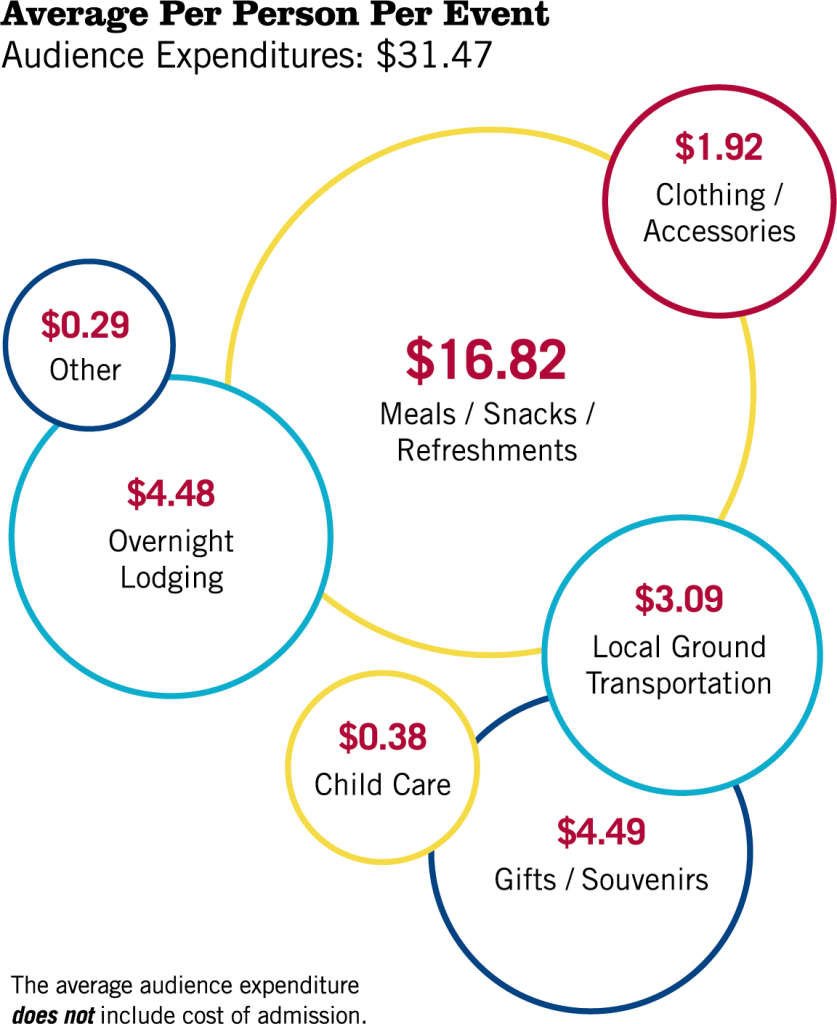Americans for the Arts’ Arts & Economic Prosperity 5 is the AFA’s fifth study of the nonprofit arts and culture industry’s impact on the economy. It documents the economic contributions of the arts in 341 diverse communities and regions across the country, representing all 50 states and the District of Columbia. (FY2015)
From coast to coast and from our smallest rural towns to our largest urban cities, America’s 100,000 nonprofit arts and cultural organizations make their communities more desirable places to live and work every day of the year. The arts provide inspiration and joy to residents, beautify public spaces, and strengthen the social fabric of our communities. Nonprofit arts and cultural organizations are also businesses. They employ people locally, purchase goods and services from local businesses, make communities more vibrant, and attract tourists. Event-related spending by arts audiences generates valuable revenue for local merchants such as restaurants, retail stores, hotels, and parking garages.
Project economists from the Georgia Institute of Technology customized an input-output analysis model for each community to provide specific and localized data on four measures of economic impact: full-time equivalent jobs, household income, and local and state government revenue. These localized models allow for the uniqueness of each local economy to be reflected in the findings. By every measure, the results are impressive and indicate that investing in the arts and culture industry supports jobs, generates government revenue, and is the cornerstone of tourism. Arts & Economic Prosperity 5 shows conclusively that, locally as well as nationally, the arts mean business.
A comprehensive description of the methodology used to complete the national study is available at www.AmericansForTheArts.org/EconomicImpact
Greater Tampa/St. Petersburg Area
Type of Region: Multi-County Region
Definition of Region Studied: Hillsborough and Pinellas Counties
Population of Region: 2,254,396
Total Industry Expenditures: $674,190,026
In Hillsborough County – nonprofit arts and cultural organizations
Generated $433 MILLION in annual economic activity
Supported 15,000 fulltime equivalent jobs
Generated $52 MILLION revenue to state and local government
Leveraged $258 MILLION event-related spending by audiences
In Pinellas County – the nonprofit arts and culture sector
Generated $241 MILLION in total economic activity
Supported 7,211 full time equivalent jobs
Generated $155.2 MILLION in household income
Delivered $29. 8 MILLION to local and state government revenue
Nationally, the nonprofit arts and culture industry generated $166.3 billion of economic activity during 2015—$63.8 billion in spending by arts and cultural organizations and an additional $102.5 billion in event-related expenditures by their audiences. This activity supported 4.6 million jobs and generated $27.5 billion in revenue to local, state, and federal governments (a yield well beyond their collective $5 billion in arts allocations). By every measure, the results are impressive.

Economic Impact of Spending by Organizations
Arts and cultural organizations are valued members of the business community. They employ people locally, purchase goods and services from within the community, are members of their Chambers of Commerce, and promote their regions. In 2015, these organizations—performing and visual arts organizations, festivals, public art programs, municipally-owned museums and arts centers, and more—pumped an estimated $63.8 billion into the nation’s economy, supporting 2.3 million jobs, providing $49.4 billion in household income, and generating $11.9 billion in total government revenue.
Economic Impact of Event-Related Audience Spending
The arts, unlike most industries, leverage significant amounts of event-related spending by their audiences. For example, part of the arts experience may include dining out, paying for parking, shopping in local retail stores, enjoying dessert after the show, and returning home to pay the babysitter. Based on the 212,691 audience-intercept surveys conducted for this study, the typical arts attendee spends $31.47 per person, per event, beyond the cost of admission. Nationally, total event-related spending was an estimated $102.5 billion during 2015. This spending supported 2.3 million jobs, provided $46.6 billion in household income, and generated $15.7 billion in total government revenue.

When a community attracts nonlocal arts attendees and cultural tourists, it harnesses significant economic rewards. In addition to spending data, researchers asked each of the 212,691 survey respondents to provide their home zip code. Attendees that live within the county in which the arts event took place were considered local; those who live outside of the county were categorized as nonlocal. While the ratio of local to nonlocal attendees is different in every community, the national sample revealed that 34.1 percent of attendees traveled from outside of the county in which the event took place (nonlocal), and 65.9 percent of attendees resided within the county (local). Nonlocal attendees spend twice as much per person as their local counterparts as a result of attending an arts event ($47.57 vs. $23.44).

Nonlocal attendees were asked about the purpose of their visit. More than two-thirds (68.9 percent) indicated that the primary purpose of their visit was “specifically to attend this arts event,” demonstrating the power of the arts to attract visitors to the community. As part of the survey, local attendees were asked about what they would have done if the arts event that they were attending was not taking place: 41 percent said they would have “traveled to a different community to attend a similar cultural event.” If a community fails to provide a variety of artistic and cultural experiences, not only will it fail to attract new dollars from cultural tourists, it will also lose the discretionary spending of its own residents who will travel elsewhere for a similar arts experience.
For more information see https://www.americansforthearts.org

